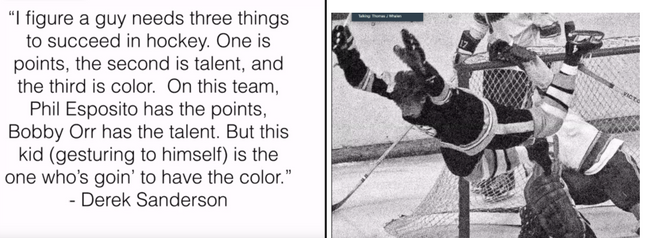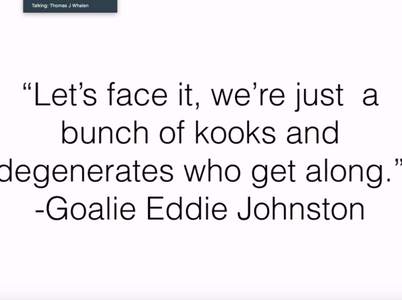Kooks and Degenerates on Ice
Tom Whalen, a CGS Associate Professor of Social Science, addressed an audience of 17 with his lecture, Kooks and Degenerates on Ice: Bobby Orr, the Big Bad Bruins, and the Stanley Cup Championship That Transformed Hockey, during BU’s Family and Friends Weekend on Oct. 17.
Whalen’s lecture delved into the history of the 1970 Bruins team while putting them into context of the history of great New England sports teams.

Before the late 1960s, hockey was a regional game primarily centered in Canada, Whalen said. Because of the popularity of the Bruins, the attendance of games went up in the U.S.
“Hockey was viewed for the Canadians by the Canadians. Bruins helped change that and made hockey a national sport,” Whalen said.
According to Whalen, the cultural upheaval of the late 1960s was critical context. The Vietnam War was still raging on and President Nixon expanded the war in the neighboring country of Cambodia during the spring of 1970. This led to riots on college campuses and deaths of students. Even BU was shut down and graduation did not occur because of the violence and protests that year.
“There was a great generation gap even more than today; students said that they were facing a civil war,” Whalen said.
As there was tension on college campuses, the early 1970s was also an experimental time in popular culture and art.
“The world of sports also reflected the times of the world,” Whalen said.
Whalen then launched into the story of The Stanley Cup Playoffs, which was started when the National Hockey League experienced major changes in 1967. They expanded their league, doubling the sizes by adding 6 U.S. teams.

There were two conferences, the Eastern Conference, the competition for the original teams, and the Western Conference, the tournament for the new teams. The Stanley Cup Playoffs was the game between the winners of each league.
Whalen described the beginning of the “big, bad Bruins,” which was founded in 1924 by Charles Adam, a grocery owner. He chose the colors brown and gold colors because that was the colors of his supermarket branding, but that was later changed to black and gold. The name of Bruins stemmed because Adam wanted the ferocious nickname.
“By the 1970s things changed, the Bruins was no longer a great team, but still continued to make history because they signed in the late 1950s, the first African American player, Willie O’Ree,” said Whalen.
Whalen then went into detail about the members of the team such as Bobby Orr, who transformed the team. Orr was signed by the age of 14 and became famous by 16 for his ability to skate around everyone and his defensive skills.
“Orr also created a finance revolution as he recorded a contract for 2 years for $50,000, which was unheard of during those days,” said Whalen. “It seemed outrageous, but it opened the door to higher salaries.”
According to Whalen, the Bruins were considered to be brawlers and had a history of doing crazy things on the ice and off the ice. Whalen gave multiple examples, like Wayne Cashman performed a strip tease in front of City Hall.

“The Bruins were the near favorites in the 1970s and they circled their calendar for that year to go all the way,” said Whalen.
The Bruins won the first seven games, but as the season wore on, they got complacent and lost their lead in their league as mentioned by Whalen.
Whalen described that the Stanley Cup was on Mother’s Day 1970 and the game went into overtime. Orr was able to score the final shot to put the Bruins on top.
“The Bruins were bigger in their time than the Patriots today,” Whalen said. “They were a part of the community and were very accessible. There was a love affair between New England and the Bruins.”
— By Natalie Seara